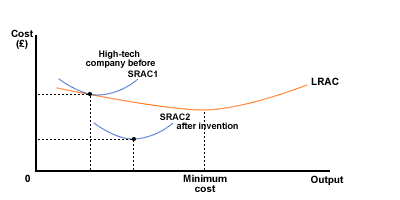The very long run
So far we have looked at the short-run and the long-run. We now meet the very long run.

Very long run
Where changes in technology make major changes in costs possible.
Invention, innovation and technological change gives some firms a huge cost advantage in some industries, and brings into existence new industries in their own right.
A new invention, protected by patent, obviously gives its inventor a huge advantage. This is the way that the pharmaceutical industry works.

Patent
A document granting monopoly powers to the inventor of something for a period of time (up to 20 years) to allow it to recover its investment and make a reasonable return on it.
Within existing industries a smallish firm making a technological breakthrough can gain a cost advantage and become dominant. Look at the diagram below.

Figure 1 Effect of technical breakthrough on competitive position of a firm
Innovation and invention has to be paid for, and research and development is an expensive exercise with no guarantee of success. Investing firms aim to protect and exploit their inventions, whilst others aim to obtain and use this research.
Major breakthroughs are few and far between, but yield big gains. They are costly.
